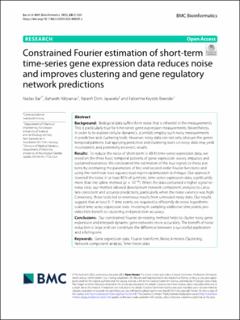| dc.contributor.author | Bar, Nadav | |
| dc.contributor.author | Nikparvar, Bahareh | |
| dc.contributor.author | Doni Jayavelu, Naresh | |
| dc.contributor.author | Roessler, Fabienne Krystin | |
| dc.date.accessioned | 2023-01-26T10:19:02Z | |
| dc.date.available | 2023-01-26T10:19:02Z | |
| dc.date.created | 2022-08-19T10:29:43Z | |
| dc.date.issued | 2022 | |
| dc.identifier.citation | BMC Bioinformatics. 2022, 23 (1), 1-21. | en_US |
| dc.identifier.issn | 1471-2105 | |
| dc.identifier.uri | https://hdl.handle.net/11250/3046551 | |
| dc.description.abstract | Background
Biological data suffers from noise that is inherent in the measurements. This is particularly true for time-series gene expression measurements. Nevertheless, in order to to explore cellular dynamics, scientists employ such noisy measurements in predictive and clustering tools. However, noisy data can not only obscure the genes temporal patterns, but applying predictive and clustering tools on noisy data may yield inconsistent, and potentially incorrect, results.
Results
To reduce the noise of short-term (< 48 h) time-series expression data, we relied on the three basic temporal patterns of gene expression: waves, impulses and sustained responses. We constrained the estimation of the true signals to these patterns by estimating the parameters of first and second-order Fourier functions and using the nonlinear least-squares trust-region optimization technique. Our approach lowered the noise in at least 85% of synthetic time-series expression data, significantly more than the spline method (p<10−6
). When the data contained a higher signal-to-noise ratio, our method allowed downstream network component analyses to calculate consistent and accurate predictions, particularly when the noise variance was high. Conversely, these tools led to erroneous results from untreated noisy data. Our results suggest that at least 5–7 time points are required to efficiently de-noise logarithmic scaled time-series expression data. Investing in sampling additional time points provides little benefit to clustering and prediction accuracy.
Conclusions
Our constrained Fourier de-noising method helps to cluster noisy gene expression and interpret dynamic gene networks more accurately. The benefit of noise reduction is large and can constitute the difference between a successful application and a failing one. | en_US |
| dc.language.iso | eng | en_US |
| dc.publisher | BMC | en_US |
| dc.rights | Navngivelse 4.0 Internasjonal | * |
| dc.rights.uri | http://creativecommons.org/licenses/by/4.0/deed.no | * |
| dc.title | Constrained Fourier estimation of short-term time-series gene expression data reduces noise and improves clustering and gene regulatory network predictions | en_US |
| dc.title.alternative | Constrained Fourier estimation of short-term time-series gene expression data reduces noise and improves clustering and gene regulatory network predictions | en_US |
| dc.type | Peer reviewed | en_US |
| dc.type | Journal article | en_US |
| dc.description.version | publishedVersion | en_US |
| dc.source.pagenumber | 1-21 | en_US |
| dc.source.volume | 23 | en_US |
| dc.source.journal | BMC Bioinformatics | en_US |
| dc.source.issue | 1 | en_US |
| dc.identifier.doi | 10.1186/s12859-022-04839-z | |
| dc.identifier.cristin | 2044418 | |
| cristin.ispublished | true | |
| cristin.fulltext | original | |
| cristin.qualitycode | 2 | |

